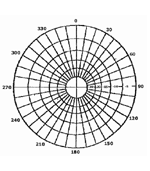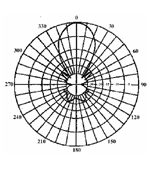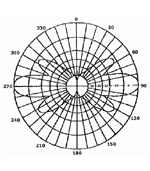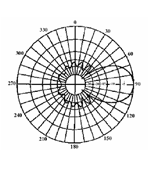This paper will help you answer important questions about antenna selection before you talk to a supplier. After reading this paper, you should be able to better determine the most important parameters you need to know for your antenna selection criteria.
Introduction
An antenna is one of the most critical junctures in any RF communications system. It’s performance determines the quality and the continuity of your data flow in both directions. Unfortunately, selection of the antenna is often deferred to the latter phases of a program and the quality of the selection is usually driven by price instead of value (quality, performance and price). Worse yet, the actual performance of the antenna in the system is seldom verified until after the system is installed, if at all.
It is important there be a level of common understanding between the system designer, the system integrator, the user and the antenna supplier regarding the required antenna performance. The joint goal of this team is to maximize the performance of the total system while minimizing cost.
This paper outlines the major questions regarding antenna parameter which should be answered prior to talking with an antenna supplier or making a final antenna selection. The reader w ill be provided with a list of useful guidelines and aides to help select the proper antenna for their application. This paper is not intended to be a theoretical treatment of antenna design. Instead it will focus on the basic elements of “specmanship” and how to determine the true “value” of an antenna.
The antenna is one of the most important components in any RF communication system. If the antenna is used for both reception and transmission, the usual case, a 1 dB increase in performance represents a 2 dB system improvement, 1 dB on receive and 1 dB on transmit. This dual path makes the antenna performance a key element in the overall system and should not be understated.
The system engineer should be as familiar with the major attributes of the antenna as with the other components of the system. To make it easier to specify the right antenna for your application while taking full advantage of the expertise of your antenna supplier, here is a list of the Top Ten Questions you should have answered before you make a final antenna selection.
The Top Ten Antenna Questions are:
• What is the operating frequency range of the system ?
• How much gain is required ?
• What kind of radiation pattern is desired?
• What is the maximum allowable VSWR?
• What polarization is required?
• What type of connector interface is required?
• How much power will the antenna have to handle?
• Where will the antenna be mounted?
• Is a radome required?
• What is the lifetime of the antenna?
What is the operating frequency range of the system?
Before you can specify an antenna, you first must know the approximate center frequency and the bandwidth over which it must operate. These two parameters will help define whether the antenna is available off-the-shelf from the designer or if a customized design is required. Most often, frequency is dictated by the application and the allocations available.
Frequency, to some extent, also dictates the size of the antenna; the lower the frequency, the larger the physical size. For example, a VHF half-wave dipole will be about three times the size of a UHF dipole. Size is particularly important when planning an installation where adequate space must be available on a tower or other location.
How much gain is required?
Antenna performance is primarily established by its gain. Gain must always be measured against a know reference. Unfortunately, there are many “so-called” gain references. Choosing the wrong reference could cost you up to 2.0 dB in performance.
Most commercial antenna suppliers specify gain in dBd (gain over a half-wave dipole). The half-wave dipole is one of the simplest and most efficient antennas. It is relatively easy to construct and has a very predictable radiation pattern similar to that of a donut. This is why most commercial antenna suppliers reference gain to a half-wave dipole.
Another reference, especially at microwave frequencies, is dBi. This term refers to gain over an isotropic radiator, a theoretical antenna that radiates equally well in all directions (such as the Sun). If an antenna is specified in dBi gain, it will appear to have approximately 2.15 dB higher gain than dBd. This may be a nifty way to impress the customer but it does not mean that you get more gain if dBi is the reference.
Beware if the supplier only quotes antenna gain in just “dB”. What is the reference? For instance, some mobile antennas are specified in dB gain over a quarter wave whip which is about 0.6 dB less gain than a dipole.
Furthermore, gain influences the type and size of an antenna. The higher the gain, the larger the antenna. Table 1 shows some of the common communication antennas and the approximate gain ranges to expect.
Table 1: Common Communication Antenna types.
| Type |
Typical Gain Range (dBd)
|
| Dipole | 0 |
| Omni | 0 |
| Gain Omni | 3 to 12 |
| Mobile Whips | -0.6 to +5.5 |
| Corner Reflector | 4 to 10 |
| Log Periodic | 3 to 8 |
| Horn | 5 to 12 |
| Helix | 5 to 15 |
| Microstrip-Patch | 3 to 15 |
| Yagi | 3 to 20 |
| Panel | 5 to 20 |
| Parabolic Dish | 10 to 30 |
As a rule of thumb, doubling the gain (a 3.0 dB increase) will increase the size of an antenna by a factor of 2-3. Properly combining two identical antennas will also increase the gain up to about 3.0 dB over that of a single antenna.
To increase the gain of a 6 foot high unity gain omni by 3 dB, the antenna will height will have to be increased to 12 to 18 feet tall!! Likewise, a Yagi antenna with a 4 foot long boom will have to increase to 8 to 12 feet along with additional elements! Table 2 can be used as a guide to assist in the selection of a Yagi antenna.
Table 2. A properly designed Yagi antenna increases in gain as the length of the boom is increased along with additional elements. This table will give some rough guidelines as to the gain, boom length and number of elements required.
To increase the gain of a 6 foot high unity gain omni by 3 dB, the antenna will height will have to be increased to 12 to 18 feet tall!! Likewise, a Yagi antenna with a 4 foot long boom will have to increase to 8 to 12 feet along with additional elements! Table 2 can be used as a guide to assist in the selection of a Yagi antenna.
Table 2. A properly designed Yagi antenna increases in gain as the length of the boom is increased along with additional elements. This table will give some rough guidelines as to the gain, boom length and number of elements required.
| Gain Range (dBd) | Boom Length (in wavelengths)* | Number of Elements |
| 3.0-4.5 | 0.1-0.25 | 2 |
| 4.5-6.5 | 0.15-0.35 | 3 |
| 6.0-7.5 | 0.3-0.5 | 4 |
| 7.0-8.5 | 0.5-0.8 | 5 |
| 8.5-10.0 | 0.8-1.2 | 6 |
| 9.0-10.5 | 1.2-1.5 | 7 |
| 10.0-11.0 | 1.5-2.0 | 8 |
| 11.0-12.0 | 2.0-2.5 | 9-10 |
| 12.0-13.0 | 2.5-3.5 | 11-13 |
| 13.0-14.0 | 3.5-4.5 | 14-18 |
* Wavelength (in inches) = 11803/F (MHZ). At 900 MHZ, 1.0 Wavelength=13.114″
Furthermore, increasing gain will decrease your beamwidth so you have to answer the next question.
What kind of radiation pattern is desired?
This is the first major delineator of antenna selection. The only way to increase gain is to concentrate power in a narrower beamwidth. The narrower the beamwidth, the greater the gain of the antenna.
A good conceptual example of this concentration is the vertical omnidirectional antenna. It is often used for line-of-sight communications with mobile stations spread out in various directions usually restricted to the horizon. We don’t have to warm the clouds, do we! If greater performance is required, the antenna gain can be increased by using a collinear type of omni that decreases the vertical beamwidth and hence concentrates more power on the horizon where it will be most beneficial. Figure 1 shows the typical radiation pattern of a gain omni antenna.
|
Figure 1. Typical radiation pattern of a gain omni antenna. ~ Click images to enlarge
|

|
|
|
E-Plane
|
H-Plane
|
Likewise, panel antennas are used to optimize a sector (typically 90 to 120 degrees in azimuth) with a narrow elevation beamwidth. Yagis, parabolic dishes and patch arrays are usually designed for high gain and hence have narrow beamwidths in both the azimuth and elevation plane. A typical high gain Yagi antenna pattern is shown in Figure 2. The gain can be further increased (and the beamwidth narrowed) by mounting multiple identical antennas in an array and properly spacing the antennas to account for phasing.
|
Figure 1. Typical radiation pattern of a gain omni antenna. ~ Click images to enlarge
|
 |
|
|
E-Plane
|
H-Plane
|
What is the maximum allowable VSWR?
VSWR (voltage-standing-wave-ratio) represents the degree with which an antenna is “matched” to the system impedance. Most modern antennas do not require any tuning for o optimum performance. VSWR is one of the easiest parameters to measure and VSWR meters are becoming very popular antenna installation tools.
Most modern antennas, receivers and transmitters are designed for peak performance when operating into a 50 Ohm transmission line. If the VSWR is too high, the transmitter power may be reduced as well as the strength of the received signal.
The typical commercial standard for maximum allowable VSWR across the entire bandwidth of a system is 1.5:1. This means that the antenna impedance must be somewhere between 37.5 and 75 Ohms. You should specify the maximum VSWR and the operating frequency bandwidth when specifying your antenna. A VSWR of 2:1 or greater usually is considered unacceptable (or for receiving purposes only) since it increases losses in the transmission line. Incidentally, decreasing the VSWR below 1.5:1 will often be expensive and will have little noticeable performance improvement.
What polarization is required?
Most communication systems use either vertical, horizontal or elliptical (RHC-right hand circular or LHC-left hand circular) polarization, with vertical dominating commercial VHF/UHF applications. In some instances, the selection is determined by the installation site, with the antenna oriented to provide the best performance. If this is anticipated, your antenna should provide mounting for either polarization.
Selecting the proper polarization for the system can enhance the overall performance by minimizing the interference from adjoining systems. For example, by installing you system orthogonal to other systems in the area, you can provide up to 20 dB of isolation. This will result in up to a 99% power reduction of the interfering system! Elliptical polarization can sometimes decrease fading.
Many systems are challenged because they must interface with handheld transmitters. These units move around a room or warehouse, with the antenna often pointing many degrees off-axis. To accommodate these application, the fixed antennas often use circular or elliptical polarization with a hemispherically shaped pattern trading off high gain for reasonable gain in all directions.
What type of connector interface is required?
This can be more fun than selecting coax. Here are a couple of rules of thumb. If you are operating below 300 MHZ, a UHF connector will generally be satisfactory although it is difficult to waterproof. Above 300 MHZ, the UHF connector induces VSWR mismatches. Type “N”, TNC and BNC connectors are preferred at higher frequencies because they maintain a good VSWR. These connectors are low loss and can handle moderate power (250 Watts) up to 1 GHz.
If high power and/or low intermodulation distortion is required, especially where multiple antenna systems are operating in close proximity, the new large 7-16 DIN connector may be required. If small size and low power operation from 1-10 GHz is anticipated, the SMA connector may be preferred.
Regardless of the quality or type of the connector, the potential exists to introduce noise, signal loss and lower reliability through every connector break in the trans mission line. An antenna with an integral jumper or “pigtail” which extends from the antenna to the feedline on the mast may be preferred. An antenna with its connector mounted right on the antenna feed point may be cheaper to buy, but add in the cost of a “jumper” cable, the signal losses, increased maintenance and you may have to reevaluate the “value” of a low cost antenna.
How much power will the antenna have to handle?
Generally speaking, this is not an important antenna parameter, especially in receive-only or low-power (less than 50 Watts) transmitter applications. The power-handling capability of an antenna is usually a function of the connector type and the transmission line (if it is an integral part of the antenna).
You should specify the “average” power that will reach the antenna. If your transmitter is emitting pulse or peak power, it is important to inform the antenna supplier the peak power level.
Where will the antenna be mounted?
While this question is easily answered, the real impact comes when assessing the total environment and whether the antenna will perform and survive once installed. Furthermore, don’t underestimate the impact of local zoning ordinances and regulations on installing antennas.
The next question is how will the antenna be mounted? If the antenna is attached to a tower or mast, what is the diameter of the pipe or mast? Will the antenna be rear or center mounted?
For an exterior mount, the integral strength of the design must be considered such as its ability to withstand wind, ice, heat/cold and other extremes. You should also assess the ability of the major components such as the feed, the radome and connectors to withstand stress. The materials and hardware used in the construction of the antenna are also important. Outside mounted antennas should use durable materials such as aluminum with stainless steel hardware. Additionally, has the antenna been designed to properly operate with 1/2″ of radial ice encrusting on it, or will it stop working until the ice melts?
The inside of buildings can also be torturous. Will a desk top antenna survive constant handling and having books and coffee cups dropped on it? Must the antenna be mounted to a wall or a ceiling? Will the antenna have t! o be disguised? Will a wall mount be used as a target? As wireless applications continue to grow, the locations for antennas will multiply and challenge the ingenuity of the designer.
Is a radome required?
Radomes serve two purposes, to protect and to hide the antenna. Increasingly, the visual impact of an antenna is being considered when making a choice. Does the antenna blend into its surroundings or is it a sore thumb? Radomes can be colored and shaped to improve aesthetics. This has proven very effective indoors as well as for outdoor applications.
Panel antennas are usually enclosed within a radome to protect the elements and/or any printed circuit boards. Yagi antennas equipped with radomes usually are more of a detriment than a value. The wind load on the antenna is significantly increased and protection offered to the antenna itself can often be offset with proper design of the feed system and the directors.
Dishes and vertical omnis all benefit from proper placement to disguise them as well! as selecting an appropriate color (such as Earth tones!) for either the radome or the exterior coating.
What is the lifetime of the antenna?
Simply put, a cheap antenna will last long enough to win the job and lose the customer while a good antenna will be warranted to meet performance specifications. The quality of the mechanical design, the individual elements of the antenna and the final product will serve the needs of the customer in the environment specified.
Finally, you define the quality of the product you will use or you will ship to an end-user. A good antenna will satisfy the customer, the maintenance crew and the bottom line. The quality of the antenna will match the quality of the relationship between you and the one who pays the bills.
Summary
As pointed out at the beginning of this paper, antenna specifications deserve more emphasis earlier in the system design phase, rather than as an afterthought. Make sure that the requirements of the installation meet the performance specifications of the manufacturer and provides value to the application.
Finally, review and fill in the answers to the questions listed here before you call any antenna suppliers. Hopefully these questions and their appropriate answers will assist you in the process of choosing the proper antenna for your application.
Antenna Technologies Limited Company and the author retain the rights to all intellectual property contained herein.
This information should be used as a guideline only to help you in the appropriate selection of an antenna.


